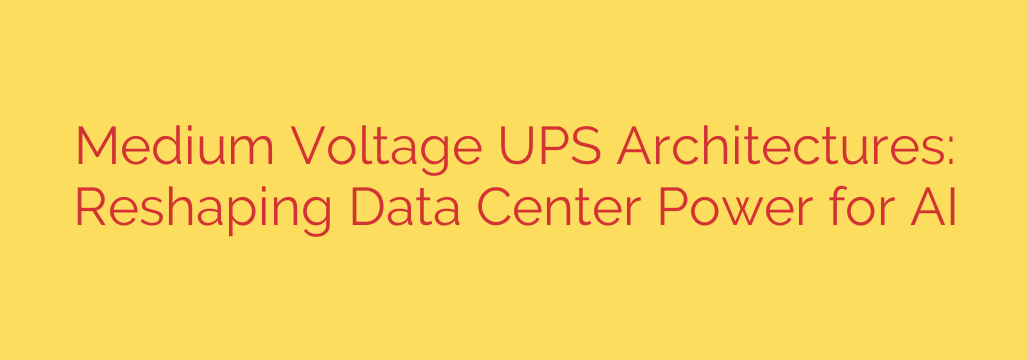
Powering the AI Revolution: The Shift to Medium Voltage UPS in Data Centers
The artificial intelligence boom is reshaping our world, but it’s also placing unprecedented demands on the digital infrastructure that powers it. AI and high-performance computing (HPC) workloads require immense computational power, leading to data center rack densities soaring from a typical 5-10 kW to over 100 kW. This dramatic increase in power consumption is pushing traditional low-voltage power architectures to their absolute limits, forcing a necessary evolution in data center design.
For decades, low-voltage systems (typically 480V or 600V) have been the standard for data center power distribution. However, as facilities scale into the hundreds of megawatts to support AI clusters, the inherent limitations of these systems become a critical bottleneck. The core challenge lies in the physics of electrical power: as power demand increases at a low voltage, the electrical current must rise dramatically. This leads to several significant problems:
- Massive Cabling Requirements: Higher currents necessitate thicker, more expensive copper cables to manage the load and heat.
- Significant Energy Losses: More current leads to greater resistive losses (I²R losses), where energy is wasted as heat, driving up operational costs and negatively impacting Power Usage Effectiveness (PUE).
- Large Physical Footprint: The extensive switchgear, transformers, and cabling required for a high-density, low-voltage system consume valuable white space that could otherwise be used for revenue-generating IT equipment.
To overcome these obstacles, forward-thinking data center operators are embracing a more efficient and scalable solution: Medium Voltage (MV) Uninterruptible Power Supply (UPS) architecture.
What is Medium Voltage Architecture?
Medium voltage power distribution utilizes voltages above 1,000 volts (1kV), often ranging from 4.16kV to 34.5kV. By distributing power at a much higher voltage, the corresponding current is significantly lower for the same amount of power delivered. This fundamental shift provides a cascade of benefits perfectly suited for the demands of modern AI data centers. An MV UPS system takes this high-voltage power from the utility, provides battery backup and conditioning at the medium-voltage level, and then steps it down to the required low voltage much closer to the IT racks.
The Core Benefits of Adopting Medium Voltage UPS
Shifting the primary power backbone to medium voltage is more than an incremental improvement; it is a strategic redesign that unlocks new levels of efficiency, scalability, and reliability.
1. Unmatched Efficiency and Lower Operational Costs
By dramatically reducing the electrical current flowing through the facility, MV architectures slash energy losses from electrical resistance by as much as 75% compared to traditional low-voltage designs. This directly translates into significant energy savings over the life of the data center. A lower energy loss means a better PUE, reducing the facility’s overall carbon footprint and delivering substantial savings on utility bills—a critical factor when dealing with multi-megawatt power loads.
2. Reclaiming Valuable Data Center Space
One of the most immediate advantages of an MV system is the reduction in the physical size of power distribution equipment. Cables can be significantly smaller, and the required switchgear has a more compact footprint. This frees up valuable floor space, allowing operators to maximize the amount of IT hardware and increase the facility’s overall profitability. In the high-stakes world of data center real estate, this space savings is a powerful competitive advantage.
3. Future-Proofing for Extreme Scalability
AI workloads are not static; they are growing exponentially. A low-voltage architecture can quickly become overwhelmed when a facility needs to scale from 50 MW to 150 MW or more. Medium voltage systems are inherently designed for high-power transmission and offer a much clearer, more manageable path to expansion. By building an MV backbone from the start, operators can future-proof their infrastructure, ensuring it can support next-generation AI hardware without a costly and disruptive overhaul.
4. Enhanced Reliability with a Simplified Design
To achieve high power capacity with a low-voltage system, operators must often parallel numerous smaller UPS units. This creates a complex web of switchgear and controls, introducing multiple potential points of failure. In contrast, an MV UPS architecture is a more centralized and streamlined design. Fewer components and a simpler power path inherently increase system resilience and reliability, which is non-negotiable for mission-critical AI applications.
5. A Lower Total Cost of Ownership (TCO)
While some individual MV components may have a higher initial cost, the overall system often results in a lower Total Cost of Ownership. Savings on copper cabling, reduced installation labor, and long-term energy efficiency gains can outweigh the upfront investment. By optimizing for the entire lifecycle of the data center, an MV approach delivers superior financial performance.
Planning for a Medium Voltage Future
Implementing an MV architecture requires careful planning and specialized expertise. The design, installation, and maintenance of high-voltage systems demand engineers and technicians with specific training and a deep understanding of advanced safety protocols, such as arc flash mitigation.
For any organization planning a new, high-density data center or a major upgrade to an existing facility, evaluating a medium-voltage UPS architecture is no longer just an option—it is a strategic necessity. As AI continues its rapid ascent, the power infrastructure that supports it must evolve. Medium voltage is the clear path forward, delivering the efficiency, scalability, and reliability required to power the next generation of innovation.
Source: https://datacenterpost.com/how-medium-voltage-ups-architectures-are-redefining-the-way-data-centers-power-up-for-ai/








